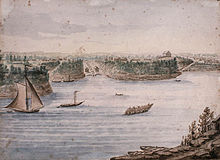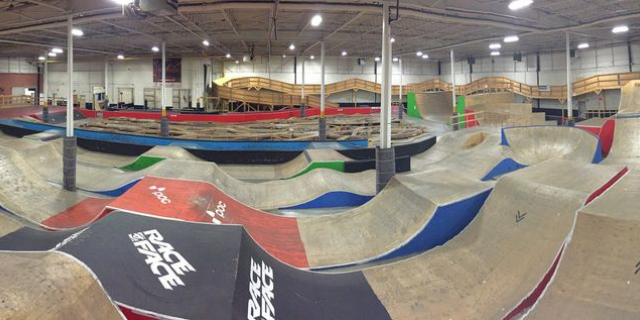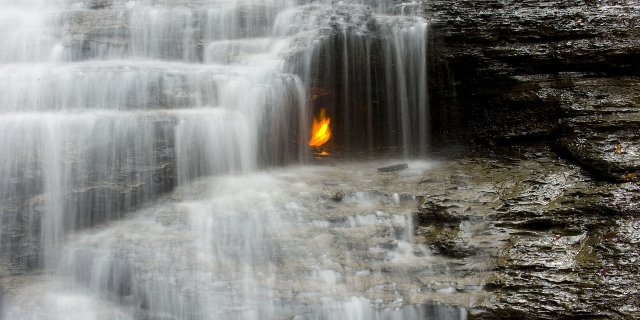Colline du Parlement
( Parliament Hill )
Parliament Hill (French: Colline du Parlement), colloquially known as The Hill, is an area of Crown land on the southern bank of the Ottawa River in downtown Ottawa, Ontario, Canada. It accommodates a suite of Gothic revival buildings whose architectural elements were chosen to evoke the history of parliamentary democracy. Parliament Hill attracts approximately three million visitors each year. The Parliamentary Protective Service is responsible for law enforcement on Parliament Hill and in the parliamentary precinct, while the National Capital Commission is responsible for maintaining the nine-hectare (22-acre) area of the grounds.
Development of the area, which in the 18th and early 19th centuries was the site of a military base, into a governmental precinct began in 1859 after Queen Victoria chose Ottawa as the capital of the Province of Canada. Following several extensions to the ...Read more
Parliament Hill (French: Colline du Parlement), colloquially known as The Hill, is an area of Crown land on the southern bank of the Ottawa River in downtown Ottawa, Ontario, Canada. It accommodates a suite of Gothic revival buildings whose architectural elements were chosen to evoke the history of parliamentary democracy. Parliament Hill attracts approximately three million visitors each year. The Parliamentary Protective Service is responsible for law enforcement on Parliament Hill and in the parliamentary precinct, while the National Capital Commission is responsible for maintaining the nine-hectare (22-acre) area of the grounds.
Development of the area, which in the 18th and early 19th centuries was the site of a military base, into a governmental precinct began in 1859 after Queen Victoria chose Ottawa as the capital of the Province of Canada. Following several extensions to the Parliament and departmental buildings, and a fire in 1916 that destroyed the Centre Block, Parliament Hill took on its present form with the completion of the Peace Tower in 1927. In 1976, the Parliament Buildings and the grounds of Parliament Hill were designated as National Historic Sites of Canada. Since 2002, an extensive $3 billion renovation-and-rehabilitation project has been underway throughout the precinct's buildings that is expected to be completed after 2028.
Parliament Hill is a limestone outcrop with a gently sloping top that was originally covered in a primeval forest of beech and hemlock.[1] For hundreds of years, the hill was a landmark on the Ottawa River for First Nations people and later for European traders, adventurers, and industrialists, marking their journeys to the interior of the continent.[1] After the founding of Ottawa, which was then called Bytown, the builders of the Rideau Canal sited a military base on the hill,[2] naming it Barrack Hill. A large fortress was planned for the site following the War of 1812 and the Upper Canada rebellion but the threat of an American invasion subsided and the project was scrapped.[2]
Selection as a parliamentary precinct The Ottawa locks of the Rideau Canal, with Barrack Hill—present-day Parliament Hill—right of centre; 1832
The Ottawa locks of the Rideau Canal, with Barrack Hill—present-day Parliament Hill—right of centre; 1832In 1858, Queen Victoria selected Ottawa as the capital of the Province of Canada. Barrack Hill was chosen as the site of the new parliament buildings for its prominence over the town and the river,[1][3] and because the Crown already owned it.[4] On 7 May 1859, the Department of Public Works issued a call for design proposals for the new parliament buildings on Barrack Hill, for which 298 drawings were submitted. The number of entries was reduced to three but the panel of judges could not decide whose design should win the contest. Governor General Sir Edmund Walker Head was approached to break the stalemate and the winners were announced on 29 August 1859.[5]
Contracts to build the Centre Block and departmental buildings were separately awarded. The first was awarded to the team of Thomas Fuller and Chilion Jones with their Victorian High Gothic scheme of a formal, symmetrical front facing a quadrangle and a more rustic, picturesque back facing the escarpment overlooking the Ottawa River. The team of Thomas Stent and Augustus Laver won the prize for the second category, which included the East and West Blocks.[5] These proposals were selected for their sophisticated use of Gothic architecture, which was thought to remind people of parliamentary democracy's history, would contradict the republican neoclassicism of the United States' capital, and would be suited to the rugged surroundings while being stately.[5] $300,000 was allocated for the main building and $120,000 for each of the departmental buildings.[6]
Construction and early use Centre Block under construction in 1863
Centre Block under construction in 1863Ground was broken on 20 December 1859 and the first stones were laid on 16 April the following year. Prince Albert Edward, Prince of Wales (later King Edward VII), laid the cornerstone of the Centre Block on 1 September.[4][3] Construction of Parliament Hill became the largest construction project undertaken in North America to that date.[7] Workers hit bedrock sooner than expected, necessitating blasting to complete the foundations, which the architects had altered to sit 5.2 metres (17 ft) deeper than originally planned.[4] By early 1861, the Canadian Department of Public Works reported over $1.4 million had been spent on the venture, leading to the closure of the site in September and the covering of the unfinished structures with tarpaulins until 1863, when construction resumed following a commission of inquiry.[4]
The site was still incomplete when three of the British North American colonies—now the provinces Ontario, Quebec, Nova Scotia, and New Brunswick—entered Confederation in 1867, and Ottawa remained the capital of the new country. Within four years, Manitoba, British Columbia, Prince Edward Island, and the North-West Territories—now Alberta, Saskatchewan, Yukon, Northwest Territories, and Nunavut—were added and, along with the associated bureaucracy, the first three required representation be added in Parliament. The offices of Parliament spread to buildings beyond Parliament Hill.[4]
 Troops deliver a feu de joie on Parliament Hill for the Queen's Birthday Review in 1868.
Troops deliver a feu de joie on Parliament Hill for the Queen's Birthday Review in 1868.The British military allocated a nine-pounder naval cannon to Ottawa's British army garrison in 1854. The newly-created government of the Dominion of Canada purchased the cannon in 1869 and fired it on Parliament Hill as the Noonday Gun, which was colloquially known as "Old Chum",[8] for many years.[9]
By 1876, the structures of Parliament Hill, and the surrounding fence and gates, were completed. The grounds were designed with the help of architects Thomas Scott and Calvert Vaux.[5] Following the death of Queen Victoria in 1901, in late September that year, Prince George, Duke of Cornwall (later King George V)—Queen Victoria's grandson—dedicated a large statue that stands on the hill in the late Queen's honour.[10][11]
Fire, incidents, and renovations The parliament buildings the morning after the fire of 1916
The parliament buildings the morning after the fire of 1916On 3 February 1916, a fire destroyed the Centre Block.[12] Despite the ongoing war, Governor General Prince Arthur, Duke of Connaught, re-laid the original cornerstone on 1 September 1916, exactly fifty-six years after his brother the future King Edward VII had first set it. Eleven years later, the rebuilt Centre Block was completed and a new, freestanding bell tower was dedicated as the Peace Tower in commemoration of the Canadians who had died during the First World War.[13][14]
Parliament Hill has hosted several significant events in Canadian history, including the first visit of the reigning Canadian sovereign King George VI and his consort Queen Elizabeth to his Parliament in 1939.[15] A huge celebration on 8 May 1945 marked Victory in Europe Day,[16] and the first raising of the country's new national flag took place on 15 February 1965.[17] Queen Elizabeth II revisited Parliament Hill on 17 April 1982 for the issuing of a royal proclamation of the enactment of the Constitution Act that year.[18]
In April 1989, armed man Charles Yacoub hijacked a Greyhound Lines bus with eleven passengers on board that was travelling to New York City from Montreal, and drove it onto the lawn in front of the Centre Block. A six-hour standoff with police ensued; three shots were fired but there were no injuries.[19]
 The special Diamond Jubilee window of Queen Elizabeth II alongside Queen Victoria's Diamond Jubilee window
The special Diamond Jubilee window of Queen Elizabeth II alongside Queen Victoria's Diamond Jubilee windowOn 14 September 2001, 100,000 people gathered on the main lawn to honour the victims of the September 11 attacks on the United States that year.[20] Queen Elizabeth II's Diamond Jubilee was commemorated with the installation of a specially tinted window in the Centre Block on 7 February 2012, one day after Accession Day.[21]
On 22 October 2014, shooting incidents occurred around Parliament Hill. After fatally shooting a Canadian Army soldier stationed as a ceremonial guard at the National War Memorial, a gunman entered the Centre Block of the parliament buildings. There, the shooter engaged in a firefight with Sergeant-at-Arms of the House of Commons Kevin Vickers and members of the Royal Canadian Mounted Police (RCMP). The incident ended when the shooter was killed by Vickers and RCMP Constable Curtis Barrett.[22][23] Following the incidents, the Parliamentary Protective Service was created to integrate the House of Commons and Senate security forces with RCMP patrols of the grounds.[23]
Since 2002, an extensive $3 billion renovation-and-rehabilitation project has been underway throughout the precinct's buildings to bring the Parliament buildings to modern safety standards and to address their deteriorated state; work is not expected to be complete until after 2028.[24][25] The West Block was completed in November 2018 before the House of Commons moved there and renovations on the Senate of Canada Building concluded in 2019 to accommodate the Senate[26][27] while the Centre Block and East Block undergo renovations.[28] Work on the Sir John A. Macdonald Building was completed in 2015[29] and work on the Wellington Building was completed in 2016.[30] An architectural competition is being held for designs pertaining to the city block south of Wellington Street and a new Visitors Welcome Centre is being built.[25][31]







































Add new comment